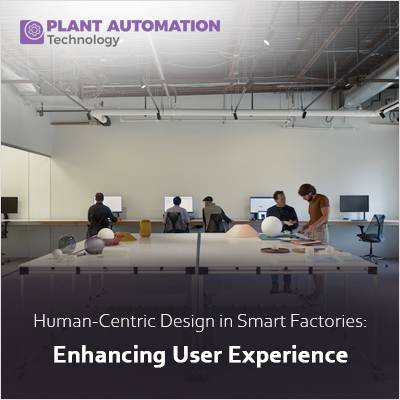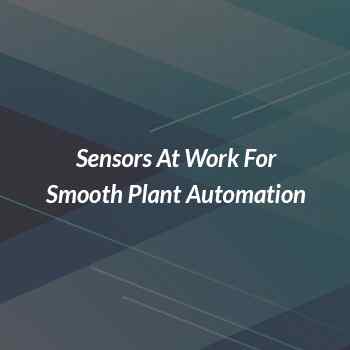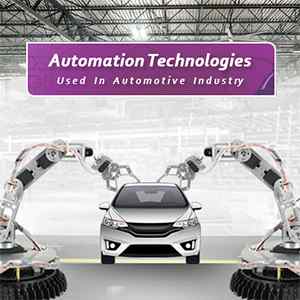Human-Centric Design in Smart Factories: Enhancing User Experience

Introduction:
In the ever-evolving realm of contemporary manufacturing, the rise of smart factories has transformed conventional production methods. Smart factories signify a fundamental change, harnessing state-of-the-art technologies like the Internet of Things (IoT), artificial intelligence (AI), and automation to enhance efficiency and productivity. These sophisticated manufacturing ecosystems surpass simple automation, adopting a comprehensive strategy that embeds data, connectivity, and intelligence into all aspects of operations.
As smart factories become the cornerstone of industrial evolution, the imperative to enhance user experience within these environments cannot be overstated. This is where the concept of human-centric design takes center stage. Human-centric design places the human factor at the forefront of technological innovation, emphasizing the creation of interfaces and systems that align seamlessly with the needs and capabilities of the individuals operating within these high-tech environments.
Amidst the escalating integration of technology into industrial environments, the significance of human-centric design becomes increasingly apparent. While technology has undoubtedly propelled manufacturing capabilities to unprecedented levels, there is a looming risk of neglecting the human element in this transformative journey. In this context, a purposeful emphasis on human-centric design emerges as a strategic necessity, ensuring that the technological advancements in smart factories not only showcase innovation but also serve as facilitators of a superior user experience for the workforce steering these changes. This article explores the intricate interplay between smart factories, human-centric design, and the continually expanding landscape of technology within industrial settings.
Understanding Human-Centric Design:
Human-centric design, frequently interchangeable with user-centered design, embodies a philosophical and methodological approach that positions the end user as the focal point of the design process. In the realm of smart factories, where technology intersects with human operators, this design philosophy takes on paramount importance. At its core, human-centric design is grounded in the principle of crafting systems, interfaces, and environments that intuitively connect with the individuals engaging with them.
Principles of Human-Centric Design:
1. Empathy: At the heart of human-centric design lies a deep understanding of the users – their needs, preferences, and challenges. By empathizing with the end user, designers can uncover insights that inform the creation of solutions tailored to the unique demands of smart factory environments.
2. Iterative Design: Human-centric design operates as an iterative process characterized by ongoing refinement guided by user feedback. This iterative approach guarantees that the ultimate product is more than just a technological feat; it becomes a tool seamlessly integrated into the daily workflows of factory workers.
3. User Involvement: In the context of smart factories, involving end users in the design process is imperative. Workers who directly engage with the technology bring invaluable insights that can shape the design to align with their expertise and preferences.
4. Usability: The usability of interfaces and systems is a cornerstone of human-centric design. Intuitive navigation, clear feedback mechanisms, and minimal cognitive load are essential elements to enhance usability within the intricate operational frameworks of smart factories.
User Research in Smart Factories:
Before the first line of code is written or the initial blueprint is drawn, user research takes precedence. This involves direct observation of factory workers, interviews, and the collection of qualitative and quantitative data to grasp the intricacies of their daily routines, pain points, and aspirations.
Comprehending the distinctive challenges confronted by workers in smart factories empowers designers to devise solutions that not only tackle existing issues but also foresee and alleviate potential future challenges in the evolving landscape of technology.
The Role of Prototyping in Human-Centric Design:
Prototyping is a pivotal stage in human-centric design, allowing designers to translate theoretical concepts into tangible, interactive models. For smart factories, prototypes can simulate the actual working environment, providing users with a hands-on experience to provide feedback and make refinements.
This iterative approach, involving users in the evolution of the design through successive prototypes, ensures that the final product aligns closely with user expectations and practical needs.
In essence, understanding human-centric design in the context of smart factories requires a holistic commitment to empathetic, iterative, and user-involved design processes. By placing the workforce at the forefront of technological advancements, human-centric design becomes the linchpin for ensuring that the synergy between humans and machines in smart factories is harmonious and highly efficient.
Challenges in Industrial Settings:
The incorporation of advanced technologies in smart factories ushers in a new era of efficiency and productivity, yet this transformation is not devoid of challenges. As industrial landscapes evolve, various obstacles arise, posing a threat to hinder progress and compromise the seamless interaction between humans and technology.
1. Complexity of Interfaces and Interactions: Smart factories implement intricate systems, often marked by complex interfaces and interactions. The challenge lies in developing technology that is sophisticated yet accessible. Workers should be able to navigate these interfaces effortlessly to ensure that technology enhances, rather than hinders, their productivity.
2. Resistance to Change: Human-centric design in smart factories frequently faces resistance from workers accustomed to traditional manufacturing processes. Introducing new technologies may be met with skepticism, fear, or a reluctance to adapt. Effectively managing this resistance and cultivating a culture of openness to change becomes a crucial element in ensuring successful integration.
3. Skills Gap: The swift pace of technological advancement may surpass the skills of the current workforce. Training employees to effectively operate and harness the full potential of smart factory technologies presents a substantial challenge. Addressing the skills gap demands strategic planning and continuous education initiatives.
4. Integration with Legacy Systems: Many industrial settings still operate with legacy systems that may not seamlessly integrate with the latest smart technologies. Upgrading without disrupting existing operations presents a complex challenge. Designing interfaces that allow for a smooth transition between legacy and modern systems becomes a critical consideration.
5. Data Security Concerns: Smart factories rely heavily on data-driven processes, raising concerns about data security and privacy. The interconnected nature of these systems creates vulnerabilities that could be exploited. Implementing robust cybersecurity measures is essential to safeguard sensitive information and maintain the integrity of operations.
6. Maintenance and Downtime: While technology promises increased efficiency, the need for maintenance and potential downtime cannot be ignored. Balancing the demands of regular maintenance without causing significant disruptions to production schedules is a delicate challenge. Human-centric design must consider how technology can facilitate streamlined maintenance processes without compromising overall productivity.
7. Lack of Standardization: In smart factories, the absence of standardized protocols can give rise to interoperability issues. When technologies from various vendors fail to communicate seamlessly, inefficiencies and bottlenecks can occur. Establishing standardized protocols and interfaces becomes crucial for fostering a cohesive and interoperable smart factory ecosystem.
8. Regulatory Compliance: The integration of technology in industrial settings brings forth a myriad of regulatory considerations. Adhering to safety and compliance standards while navigating the complexities of rapidly evolving technology poses a continuous challenge. Human-centric design must encompass regulatory compliance to ensure the well-being of workers and the adherence to industry standards.
Tackling these challenges demands a comprehensive approach that extends beyond technological innovation. Human-centric design assumes a crucial role in alleviating these obstacles, guaranteeing that the infusion of technology into smart factories is not only effective but also mindful of the human element. Through a proactive understanding and addressing of these challenges, industries can chart a course for a smooth and transformative transition to smart manufacturing.
Key Components of Human-Centric Design in Smart Factories:
Human-centric design in the context of smart factories involves a strategic integration of principles and practices that prioritize the well-being, efficiency, and satisfaction of the workforce. The success of this design approach hinges on several key components that collectively contribute to creating an environment where humans and technology coalesce seamlessly.
1. User Research: Thorough user research establishes the bedrock of human-centric design. Grasping the needs, preferences, and challenges of factory workers through direct observation, interviews, and data analysis empowers designers to customize solutions that resonate with the real-life experiences of those interacting with the technology daily.
2. User-Friendly Interfaces: Designing intuitive and user-friendly interfaces is paramount. In smart factories, where workers engage with complex machinery and systems, interfaces should facilitate easy navigation and interaction. This involves minimizing cognitive load, providing clear feedback, and ensuring that interfaces align with the mental models of the users.
3. Ergonomics: Factoring in the physical well-being of workers constitutes a vital element of human-centric design. The application of ergonomic principles informs the design of workspaces, tools, and equipment to foster comfort, alleviate strain, and improve overall efficiency. Designing interfaces and machinery with a focus on ergonomics contributes to cultivating a healthier and more productive workforce.
4. Training and Support Systems: Human-centric design goes beyond the initial implementation. Offering effective training programs and continuous support systems ensures that workers possess the knowledge and skills needed to operate and troubleshoot smart factory technologies. This proactive approach reduces frustration, minimizes errors, and maximizes the potential of the workforce.
5. Accessibility Considerations: Smart factories should be inclusive, considering the diverse abilities and needs of the workforce. Designing technologies that are accessible to individuals with varying levels of expertise and physical capabilities is integral to human-centric design. This inclusivity enhances the overall usability and effectiveness of the technology.
6. Feedback Mechanisms: Creating systems that incorporate clear and immediate feedback mechanisms is essential. Workers should receive real-time information about the status of processes, potential issues, and their own actions. This transparency enhances situational awareness, allowing for quicker decision-making and a more responsive workflow.
7. Flexibility and Adaptability: Human-centric design acknowledges the dynamic nature of industrial environments. Designing systems that are flexible and adaptable to changing needs and circumstances ensures that smart factories can evolve alongside technological advancements and shifting operational requirements.
8. Collaboration Spaces: Fostering collaboration and communication stands as a pivotal element of human-centric design. Crafting physical and digital spaces that encourage effective teamwork and information sharing contributes to cultivating a positive work culture. This collaboration is essential for tackling complex challenges and tapping into the collective intelligence of the workforce.
9. Aesthetic and Emotional Considerations: The aesthetic and emotional aspects of the work environment are not to be overlooked. Human-centric design considers the overall atmosphere of the workplace, acknowledging the impact of aesthetics on the well-being and satisfaction of workers. Creating a visually appealing and emotionally supportive environment contributes to a positive user experience.
10. Continuous Improvement: Human-centric design is an iterative process. Implementing mechanisms for continuous improvement based on user feedback, evolving technologies, and changing operational requirements ensures that smart factories remain responsive to the needs of the workforce over time.
In essence, the key components of human-centric design in smart factories revolve around understanding, empowering, and enhancing the human experience in conjunction with technological advancements. By incorporating these components into the design process, industries can foster a harmonious integration of humans and technology, ultimately optimizing efficiency, safety, and job satisfaction within smart factory environments.
Benefits of Human-Centric Design in Smart Factories:
Human-centric design in smart factories yields a myriad of benefits that extend beyond the immediate improvements in user experience. By placing the human element at the forefront of technological innovation, industries can unlock enhanced efficiency, safety, and overall satisfaction within their manufacturing ecosystems.
1. Enhanced Efficiency: A primary advantage of human-centric design lies in the substantial improvement of operational efficiency. User-friendly interfaces, streamlined workflows, and intuitive systems decrease the time and effort needed to execute tasks. This results in heightened productivity and a more effective utilization of resources within smart factories.
2. Enhanced Safety: Prioritizing user experience inherently contributes to improved safety within smart factories. Intuitive interfaces and ergonomic design principles minimize the risk of errors and accidents. Workers can navigate and operate machinery with greater confidence, reducing the likelihood of workplace injuries and ensuring a safer working environment.
3. Reduced Downtime: Human-centric design includes considerations for maintenance processes and troubleshooting. By designing systems that are easy to maintain and providing effective training, smart factories can minimize downtime associated with repairs and technical issues. This proactive approach contributes to continuous operations and improved overall productivity.
4. Higher Worker Satisfaction: A positive user experience directly translates to higher job satisfaction. Workers in smart factories, equipped with user-friendly technology that aligns with their needs and abilities, experience reduced frustration and stress. This fosters a more positive work environment, contributing to higher morale and job retention rates.
5. Enhanced Adaptability to Change: Smart factories operate in dynamic environments where technology evolves rapidly. Human-centric design ensures that workers are not only adept at using existing technologies but are also more adaptable to change. This adaptability is crucial for industries to stay competitive and embrace future advancements seamlessly.
6. Increased Collaboration: Designing collaborative spaces and systems that promote communication fosters a culture of teamwork. Human-centric design encourages collaboration among workers, leading to a more efficient exchange of ideas and solutions. This collective intelligence enhances problem-solving capabilities and innovation within smart factories.
7. Reduced Training Time and Costs: Intuitive interfaces and user-focused design reduce the learning curve for new technologies. This, in turn, decreases the time and costs associated with training programs. Workers can quickly grasp the functionality of systems, allowing for a smoother transition during technology upgrades or the onboarding of new employees.
8. Optimal Resource Utilization: Efficient workflows and streamlined processes resulting from human-centric design lead to optimal resource utilization. This includes the effective use of machinery, reduced energy consumption, and a minimized environmental footprint. Smart factories that prioritize human-centered approaches contribute to sustainable and responsible manufacturing practices.
9. Enhanced Product Quality: The emphasis on user experience extends to the m. manufacturing of high-quality products. Human-centric design guarantees that workers can operate machinery with precision and accuracy, thereby reducing the likelihood of errors in the production process. This meticulous attention to detail elevates the overall quality of products emerging from smart factories.
10. Competitive Advantage: Industries that embrace human-centric design gain a competitive advantage. Workers in environments that prioritize their experience are more motivated, creative, and resilient. This positive work culture can attract top talent, enhance the company's reputation, and position it as a leader in the industry.
The benefits of human-centric design in smart factories are diverse and impactful. By aligning technology with the needs and capabilities of the workforce, industries can create environments that not only optimize efficiency and safety but also foster a positive and sustainable future for manufacturing.
Conclusion:
In the relentless pursuit of technological advancement, it is imperative not to overlook the human element in smart factories. Human-centric design emerges as the bridge between cutting-edge technology and the workers who bring it to life. By understanding and integrating the needs of users into the design process, smart factories can unlock unprecedented levels of efficiency, safety, and worker satisfaction. As we navigate the future of manufacturing, the success of smart factories will increasingly hinge on their ability to put people at the center of innovation.







